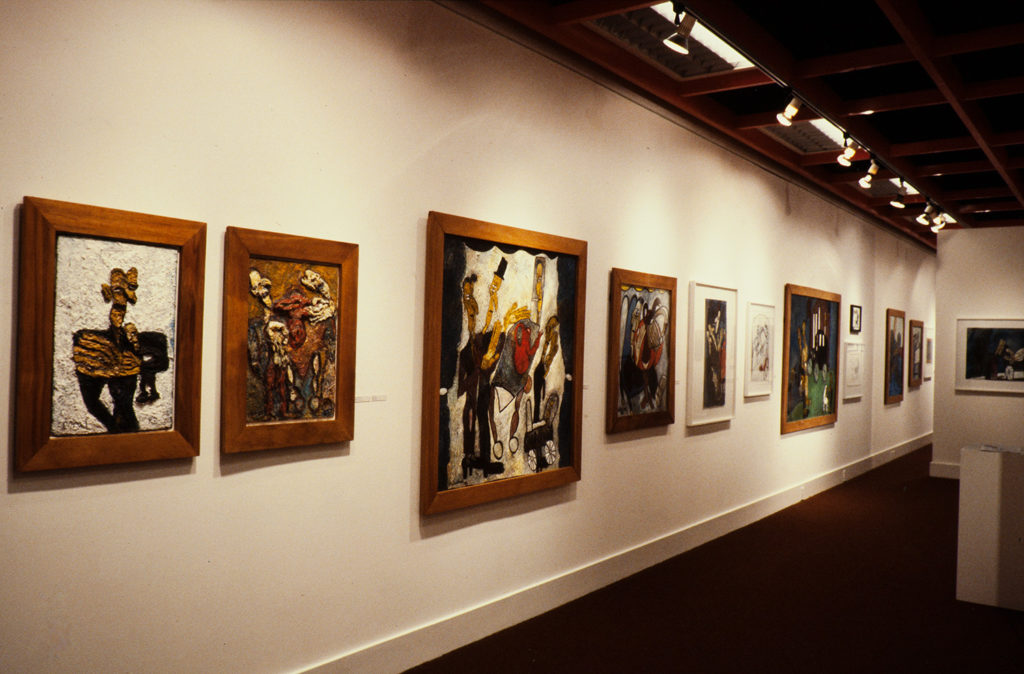PUBLICATION essay Ian Wedde, interview Anne Kirker
Christina Conrad's first and only public-gallery survey show features seventy works, including paintings, drawings, and clay 'icons'. Conrad is forty-five years old and has been painting for over twenty years, but has only exhibited her work in the last three—through her Wellington dealer, Brooker Gallery. Despite her short exhibiting history, many of the works are lent by private collectors. She has yet to be acquired by a public collection. Conrad was also the subject of a twenty-minute Kaleidoscope documentary in 1986, which plays in the show.
Conrad has lived in remote places, from the French Pyrennes to the Wakamarina Valley in Marlborough, where she met her second husband Heinrich Conrad. (In her paintings, he is referred to as 'the stone carver'.) The couple live in Avoca Valley, outside Dargaville, with their two small sons. They have no electricity or modern appliances and keep a nanny goat. They can only make art during daylight. At night, possums feed on vegetable scraps they leave out by their backdoor. When Conrad attends the show with her four-year-old Julius, Heinrich stays back to mind the farm.
The show is organised chronologically, so viewers can follow Conrad's development. Her imagery is consistent: birthing, coupling, ritualistic celebrations. Her paintings are characterised by dark outlines and an earthy palette, but, from the mid-1970s to the mid-1980s, they become more abstract. In recent works, like The Last Supper (1987), Conrad mixes oil paint with titanium oxide and clay, so her paint skins shrink, wrinkle, and crust. 'I took the paint by the throat and mastered it', she tells the Evening Post. For five years, she worked solely with clay. The collection of small clay icons are all from her home. The wooden frames that surround her works are made from kauri by her husband, Heinrich.
In the catalogue, Ian Wedde calls Conrad's work 'conscious primitivism'. It has also been compared to medieval icons. 'Throughout her work there are rhythms which express the spontaneity of a child but with the dexterity of a master conductor', writes reviewer Pauline Clayton, in Contact magazine. Picasso is a reference point, particularly his African-inspired work. Conrad's childhood home had Picasso prints on the walls. She began painting seriously aged twenty-seven, after the death of her first child, when she lived on Waiheke Island with her first husband Norman Bilbrough (their daughter Miro Bilbrough later becomes an art writer, then filmmaker). Conrad destroyed most of her early paintings. Only three remain. All are in the show. One, The Birth of Paola (1970), is the show's starting point.
Conrad says her creativity is wedded to domesticity. 'I'm mad on tables and kitchens, all the paraphernalia of kitchens. I love teapots and lemons with those little taut nipples on them. I painted those jugs over and over. I can't resist jugs.' Her titles bear this out: Lying on a Bed like a Swooning Plate (1979), The Artist and the Life of the Cerulian Pot (1984), The Red Jug (1985). Titles also offer a wry take on the art world: Two Faces of a Dealer and The Artist Entertaining the Dealers (both 1985).























